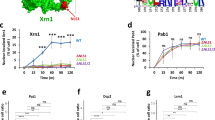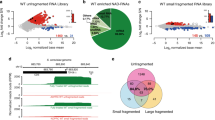Abstract
Conserved translin–TRAX complexes, also known as C3POs, have been implicated in many biological processes, but how they function remains unclear. Recently, C3PO was shown to be an endoRNase that promotes RNA interference (RNAi) in animal cells. Here, we show that C3PO does not play a significant role in RNAi in the filamentous fungus Neurospora crassa. Instead, the Neurospora C3PO functions as an RNase that removes the 5′ pre-tRNA fragments after the processing of pre-tRNAs by RNase P. In addition, translin and trax mutants have elevated levels of tRNA and protein translation and are more resistant to a cell death–inducing agent. Finally, we show that C3PO is also involved in tRNA processing in mouse embryonic fibroblast cells. This study identifies the endogenous RNA substrates of C3PO and provides a potential explanation for its roles in apparently diverse biological processes.
This is a preview of subscription content, access via your institution
Access options
Subscribe to this journal
Receive 12 print issues and online access
$189.00 per year
only $15.75 per issue
Buy this article
- Purchase on Springer Link
- Instant access to full article PDF
Prices may be subject to local taxes which are calculated during checkout







Similar content being viewed by others
References
Jaendling, A. & McFarlane, R.J. Biological roles of translin and translin-associated factor-X: RNA metabolism comes to the fore. Biochem. J. 429, 225–234 (2010).
Jaendling, A., Ramayah, S., Pryce, D.W. & McFarlane, R.J. Functional characterisation of the Schizosaccharomyces pombe homologue of the leukaemia-associated translocation breakpoint binding protein translin and its binding partner, TRAX. Biochim. Biophys. Acta 1783, 203–213 (2008).
Li, Z., Wu, Y. & Baraban, J.M. The Translin/Trax RNA binding complex: clues to function in the nervous system. Biochim. Biophys. Acta 1779, 479–485 (2008).
Laufman, O., Ben Yosef, R., Adir, N. & Manor, H. Cloning and characterization of the Schizosaccharomyces pombe homologs of the human protein Translin and the Translin-associated protein TRAX. Nucleic Acids Res. 33, 4128–4139 (2005).
Yang, S. et al. Translin-associated factor X is post-transcriptionally regulated by its partner protein TB-RBP, and both are essential for normal cell proliferation. J. Biol. Chem. 279, 12605–12614 (2004).
Aoki, K. et al. A novel gene, Translin, encodes a recombination hotspot binding protein associated with chromosomal translocations. Nat. Genet. 10, 167–174 (1995).
Kasai, M. et al. The translin ring specifically recognizes DNA ends at recombination hot spots in the human genome. J. Biol. Chem. 272, 11402–11407 (1997).
Wang, J., Boja, E.S., Oubrahim, H. & Chock, P.B. Testis brain ribonucleic acid-binding protein/translin possesses both single-stranded and double-stranded ribonuclease activities. Biochemistry 43, 13424–13431 (2004).
Suseendranathan, K. et al. Expression pattern of Drosophila translin and behavioral analyses of the mutant. Eur. J. Cell Biol. 86, 173–186 (2007).
Chennathukuzhi, V. et al. Mice deficient for testis-brain RNA-binding protein exhibit a coordinate loss of TRAX, reduced fertility, altered gene expression in the brain, and behavioral changes. Mol. Cell. Biol. 23, 6419–6434 (2003).
Stein, J.M. et al. Behavioral and neurochemical alterations in mice lacking the RNA-binding protein translin. J. Neurosci. 26, 2184–2196 (2006).
Wu, X.Q., Xu, L. & Hecht, N.B. Dimerization of the testis brain RNA-binding protein (translin) is mediated through its C-terminus and is required for DNA- and RNA-binding. Nucleic Acids Res. 26, 1675–1680 (1998).
Liu, Y. et al. C3PO, an endoribonuclease that promotes RNAi by facilitating RISC activation. Science 325, 750–753 (2009).
Ye, X. et al. Structure of C3PO and mechanism of human RISC activation. Nat. Struct. Mol. Biol. 18, 650–657 (2011).
Bühler, M. & Moazed, D. Transcription and RNAi in heterochromatic gene silencing. Nat. Struct. Mol. Biol. 14, 1041–1048 (2007).
Ghildiyal, M. & Zamore, P.D. Small silencing RNAs: an expanding universe. Nat. Rev. Genet. 10, 94–108 (2009).
Liu, Q. & Paroo, Z. Biochemical principles of small RNA pathways. Annu. Rev. Biochem. 79, 295–319 (2010).
Siomi, H. & Siomi, M.C. On the road to reading the RNA-interference code. Nature 457, 396–404 (2009).
Tian, Y. et al. Multimeric assembly and biochemical characterization of the Trax-translin endonuclease complex. Nat. Struct. Mol. Biol. 18, 658–664 (2011).
Catalanotto, C., Nolan, T. & Cogoni, C. Homology effects in Neurospora crassa. FEMS Microbiol. Lett. 254, 182–189 (2006).
Li, L., Chang, S.S. & Liu, Y. RNA interference pathways in filamentous fungi. Cell. Mol. Life Sci. 67, 3849–3863 (2010).
Maiti, M., Lee, H.C. & Liu, Y. QIP, a putative exonuclease, interacts with the Neurospora Argonaute protein and facilitates conversion of duplex siRNA into single strands. Genes Dev. 21, 590–600 (2007).
Lee, H.C. et al. qiRNA is a new type of small interfering RNA induced by DNA damage. Nature 459, 274–277 (2009).
Lee, H.C. et al. Diverse pathways generate microRNA-like RNAs and Dicer-independent small interfering RNAs in fungi. Mol. Cell 38, 803–814 (2010).
Choudhary, S. et al. A double-stranded-RNA response program important for RNA interference efficiency. Mol. Cell. Biol. 27, 3995–4005 (2007).
Colot, H.V. et al. A high-throughput gene knockout procedure for Neurospora reveals functions for multiple transcription factors. Proc. Natl. Acad. Sci. USA 103, 10352–10357 (2006).
Romano, N. & Macino, G. Quelling: transient inactivation of gene expression in Neurospora crassa by transformation with homologous sequences. Mol. Microbiol. 6, 3343–3353 (1992).
Hartmann, R.K., Gossringer, M., Spath, B., Fischer, S. & Marchfelder, A. The making of tRNAs and more—RNase P and tRNase Z. Prog. Mol. Biol. Transl. Sci. 85, 319–368 (2009).
Phizicky, E.M. & Hopper, A.K. tRNA biology charges to the front. Genes Dev. 24, 1832–1860 (2010).
Walker, S.C. & Engelke, D.R. Ribonuclease P: the evolution of an ancient RNA enzyme. Crit. Rev. Biochem. Mol. Biol. 41, 77–102 (2006).
Catalanotto, C. et al. Redundancy of the two dicer genes in transgene-induced posttranscriptional gene silencing in Neurospora crassa. Mol. Cell. Biol. 24, 2536–2545 (2004).
Cogoni, C. & Macino, G. Gene silencing in Neurospora crassa requires a protein homologous to RNA-dependent RNA polymerase. Nature 399, 166–169 (1999).
Lee, H.C. et al. The DNA/RNA-dependent RNA polymerase QDE-1 generates aberrant RNA and dsRNA for RNAi in a process requiring replication protein A and a DNA helicase. PLoS Biol. 8, e1000496 (2010).
Shiu, P.K., Raju, N.B., Zickler, D. & Metzenberg, R.L. Meiotic silencing by unpaired DNA. Cell 107, 905–916 (2001).
Castro, A., Lemos, C., Falcao, A., Glass, N.L. & Videira, A. Increased resistance of complex I mutants to phytosphingosine-induced programmed cell death. J. Biol. Chem. 283, 19314–19321 (2008).
Zasloff, M., Santos, T., Romeo, P. & Rosenberg, M. Transcription and precursor processing of normal and mutant human tRNAiMet genes in a homologous cell-free system. J. Biol. Chem. 257, 7857–7863 (1982).
Nashimoto, M., Wesemann, D.R., Geary, S., Tamura, M. & Kaspar, R.L. Long 5′ leaders inhibit removal of a 3′ trailer from a precursor tRNA by mammalian tRNA 3′ processing endoribonuclease. Nucleic Acids Res. 27, 2770–2776 (1999).
Galagan, J.E. et al. The genome sequence of the filamentous fungus Neurospora crassa. Nature 422, 859–868 (2003).
Randau, L., Schroder, I. & Soll, D. Life without RNase P. Nature 453, 120–123 (2008).
Lee, Y.S., Shibata, Y., Malhotra, A. & Dutta, A. A novel class of small RNAs: tRNA-derived RNA fragments (tRFs). Genes Dev. 23, 2639–2649 (2009).
Nunes, C.C. et al. Diverse and tissue-enriched small RNAs in the plant pathogenic fungus, Magnaporthe oryzae. BMC Genomics 12, 288 (2011).
Cole, C. et al. Filtering of deep sequencing data reveals the existence of abundant Dicer-dependent small RNAs derived from tRNAs. RNA 15, 2147–2160 (2009).
Ivanov, P., Emara, M.M., Villen, J., Gygi, S.P. & Anderson, P. Angiogenin-induced tRNA fragments inhibit translation initiation. Mol. Cell 43, 613–623 (2011).
Ishida, R. et al. A role for the octameric ring protein, Translin, in mitotic cell division. FEBS Lett. 525, 105–110 (2002).
Ebbole, D. & Sachs, M.S. A rapid and simple method for isolation of Neurospora crassa homokaryons using microconidia. Fungal Genet. Newsl. 37, 17–18 (1990).
He, Q., Cheng, P., He, Q. & Liu, Y. The COP9 signalosome regulates the Neurospora circadian clock by controlling the stability of the SCFFWD-1 complex. Genes Dev. 19, 1518–1531 (2005).
Davis, R.L. & deSerres, D. Genetic and microbial research techniques for Neurospora crassa. Methods Enzymol. 27A, 79–143 (1970).
Lewis, Z.A. et al. Relics of repeat-induced point mutation direct heterochromatin formation in Neurospora crassa. Genome Res. 19, 427–437 (2009).
Pall, G.S., Codony-Servat, C., Byrne, J., Ritchie, L. & Hamilton, A. Carbodiimide-mediated cross-linking of RNA to nylon membranes improves the detection of siRNA, miRNA and piRNA by northern blot. Nucleic Acids Res. 35, e60 (2007).
Cheng, P., Yang, Y., Heintzen, C. & Liu, Y. Coiled-coil domain mediated FRQ-FRQ interaction is essential for its circadian clock function in Neurospora. EMBO J. 20, 101–108 (2001).
Garceau, N., Liu, Y., Loros, J.J. & Dunlap, J.C. Alternative initiation of translation and time-specific phosphorylation yield multiple forms of the essential clock protein FREQUENCY. Cell 89, 469–476 (1997).
Acknowledgements
We thank H. Yuan and Q. Ye in Y.L.'s lab at U.T. Southwestern Medical Center for technical assistance and Ying Liu and X. Ye in Q.L.'s lab for providing the recombinant Drosophila C3PO and for advice on C3PO purification. This work was supported by grants from the US National Institutes of Health (R01 GM062591 and R01 GM084283 to Y.L., R01GM084010 to Q.L. and R01GM058800 to C.C.M.) and from the Welch Foundation (I-1560 to Y.L. and I-1608 to Q.L.). C.C.M. is supported as a Howard Hughes Medical Institute Investigator.
Author information
Authors and Affiliations
Contributions
L.L. designed, conducted and interpreted experiments. W.G. performed sRNA sequencing and analyses. C.L. prepared RNA from MEFs. C.C.M. and Q.L. interpreted experimental results. Y.L. designed and interpreted experiments and wrote the paper.
Corresponding author
Ethics declarations
Competing interests
The authors declare no competing financial interests.
Supplementary information
Supplementary Text and Figures
Supplementary Figures 1–5 and Supplementary Tables 1–3 (PDF 3846 kb)
Rights and permissions
About this article
Cite this article
Li, L., Gu, W., Liang, C. et al. The translin–TRAX complex (C3PO) is a ribonuclease in tRNA processing. Nat Struct Mol Biol 19, 824–830 (2012). https://doi.org/10.1038/nsmb.2337
Received:
Accepted:
Published:
Issue Date:
DOI: https://doi.org/10.1038/nsmb.2337
This article is cited by
-
Translin: A multifunctional protein involved in nucleic acid metabolism
Journal of Biosciences (2019)
-
Structural basis for duplex RNA recognition and cleavage by Archaeoglobus fulgidus C3PO
Nature Structural & Molecular Biology (2013)
-
Molecular Evolution of Translin Superfamily Proteins Within the Genomes of Eubacteria, Archaea and Eukaryotes
Journal of Molecular Evolution (2012)



